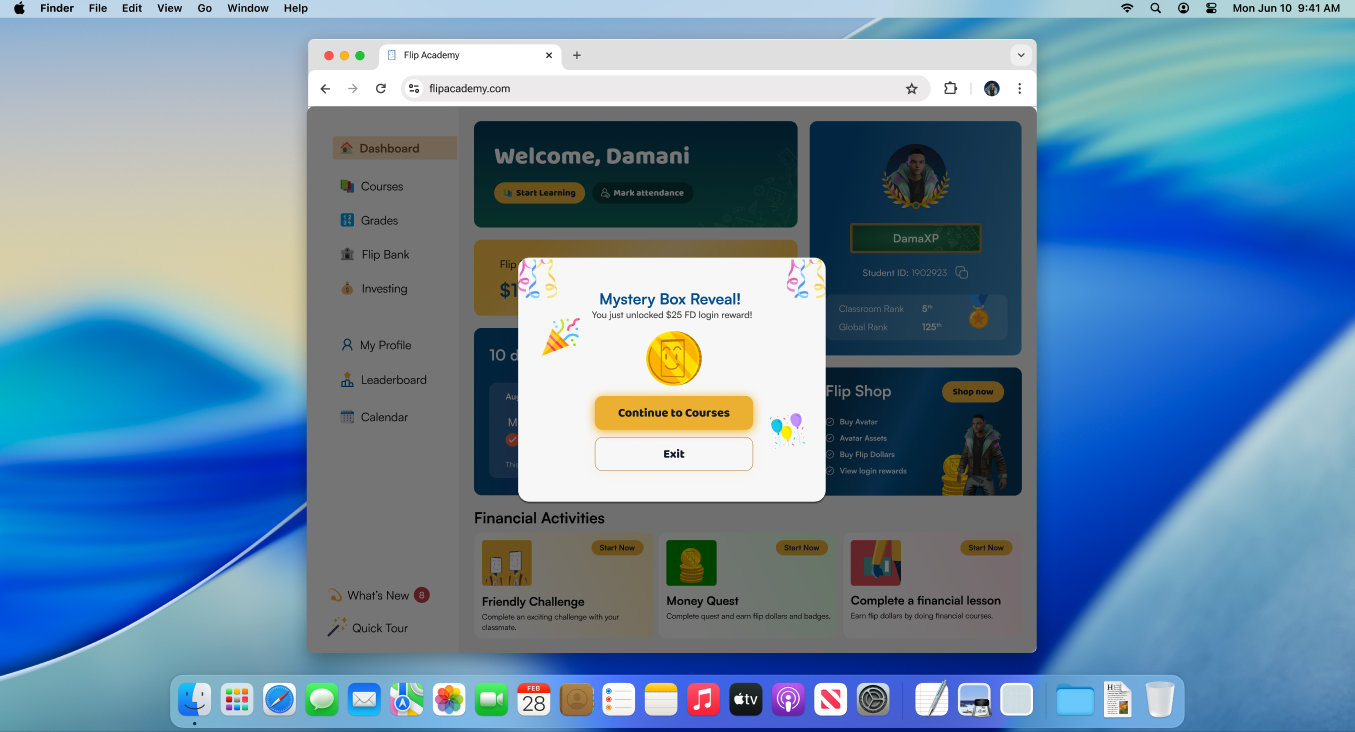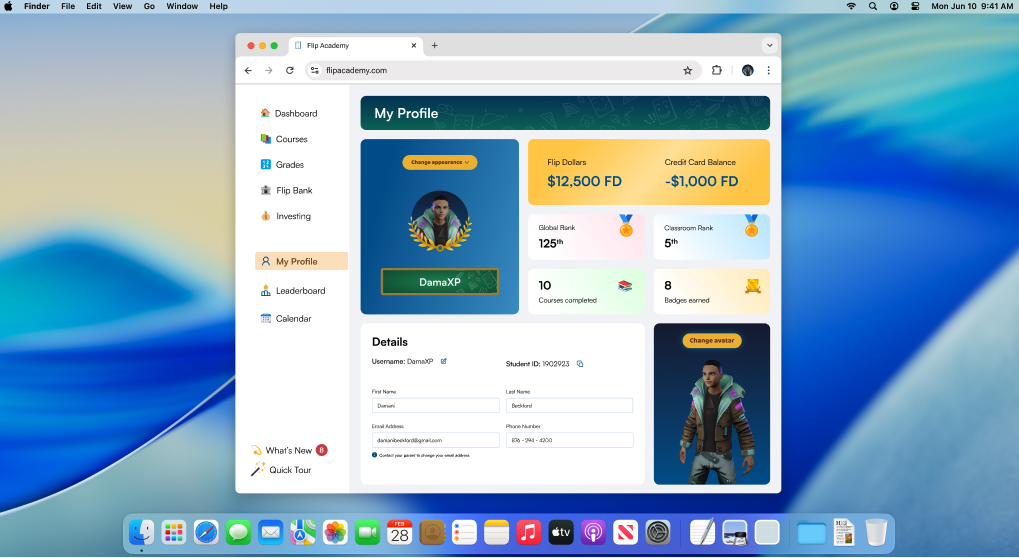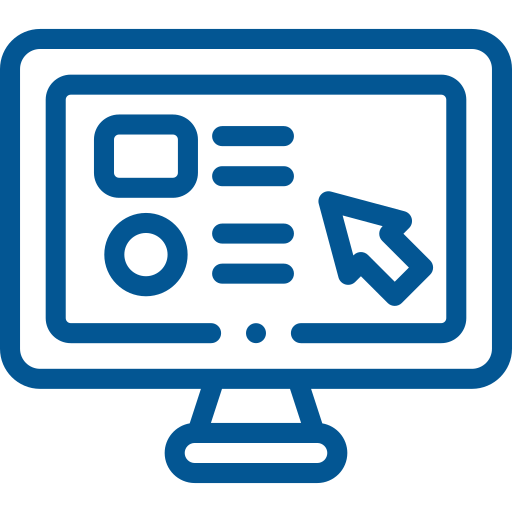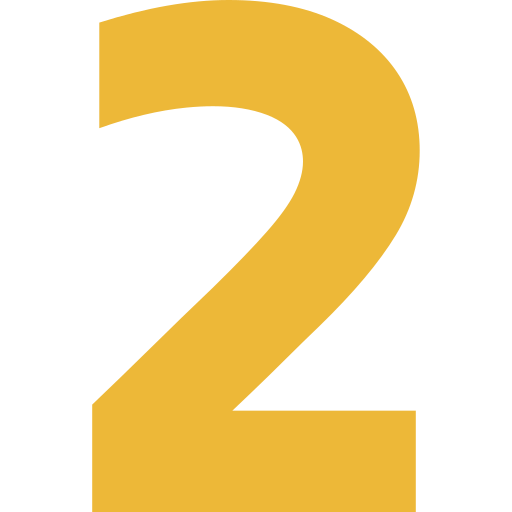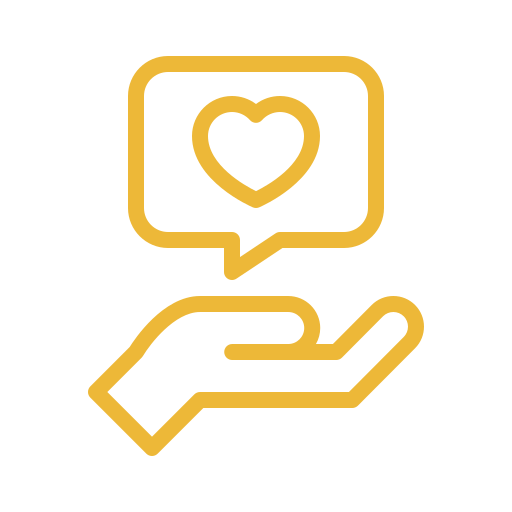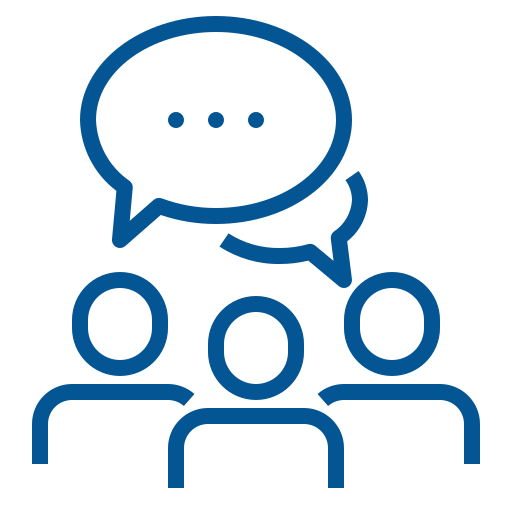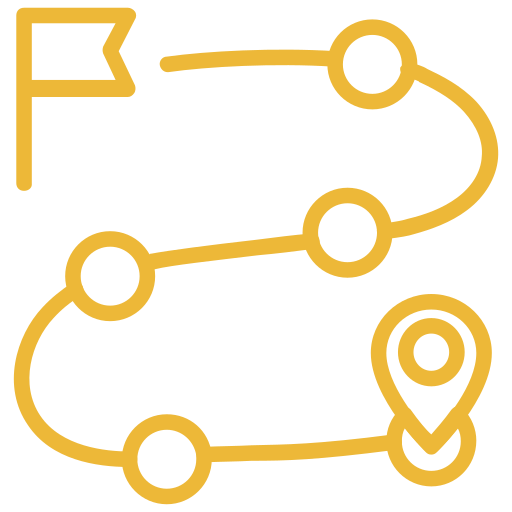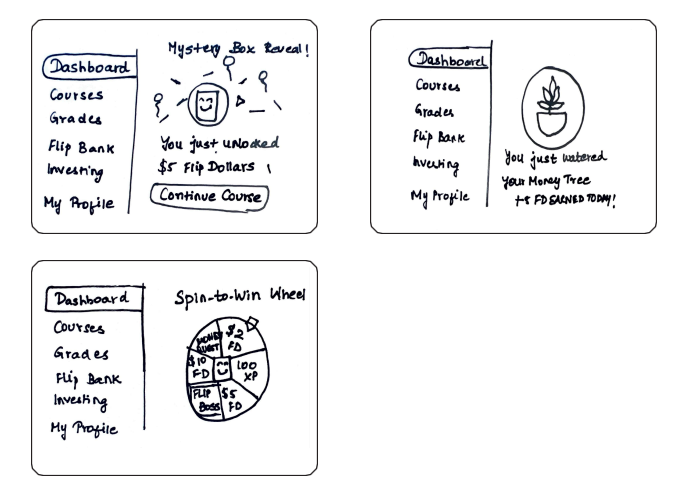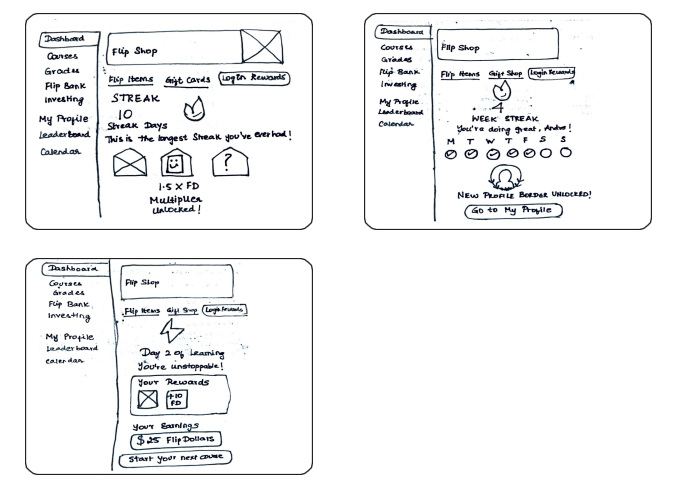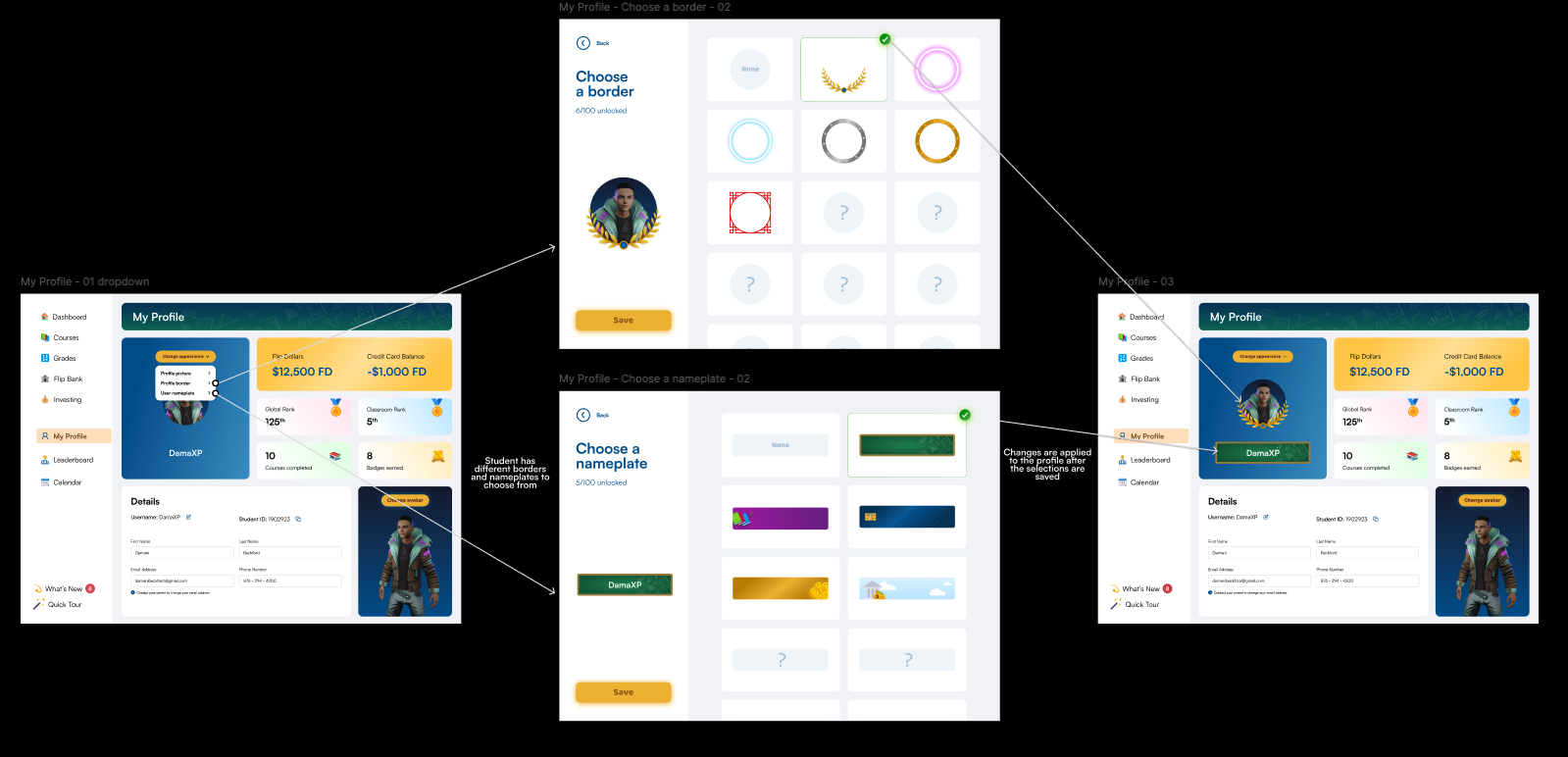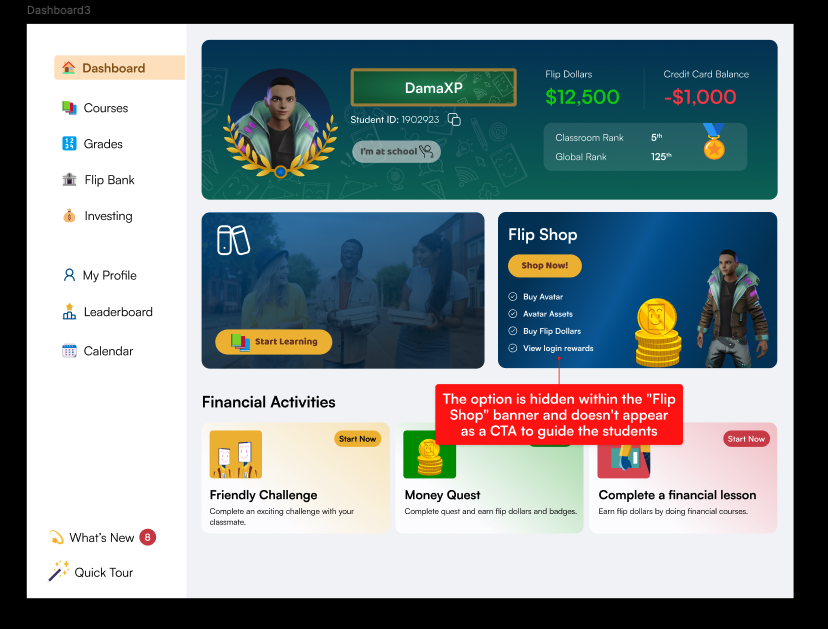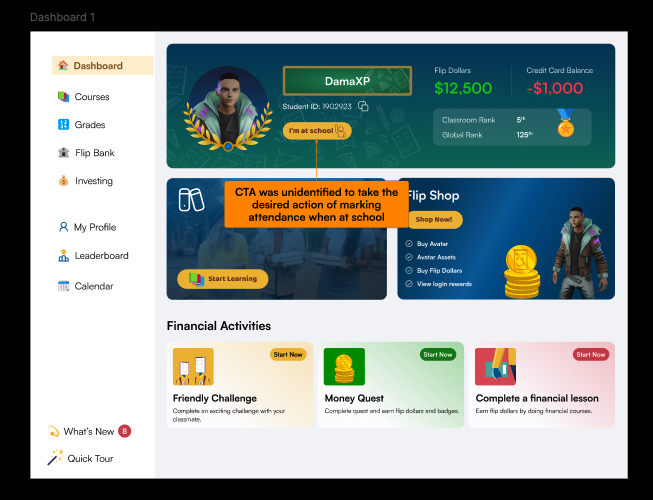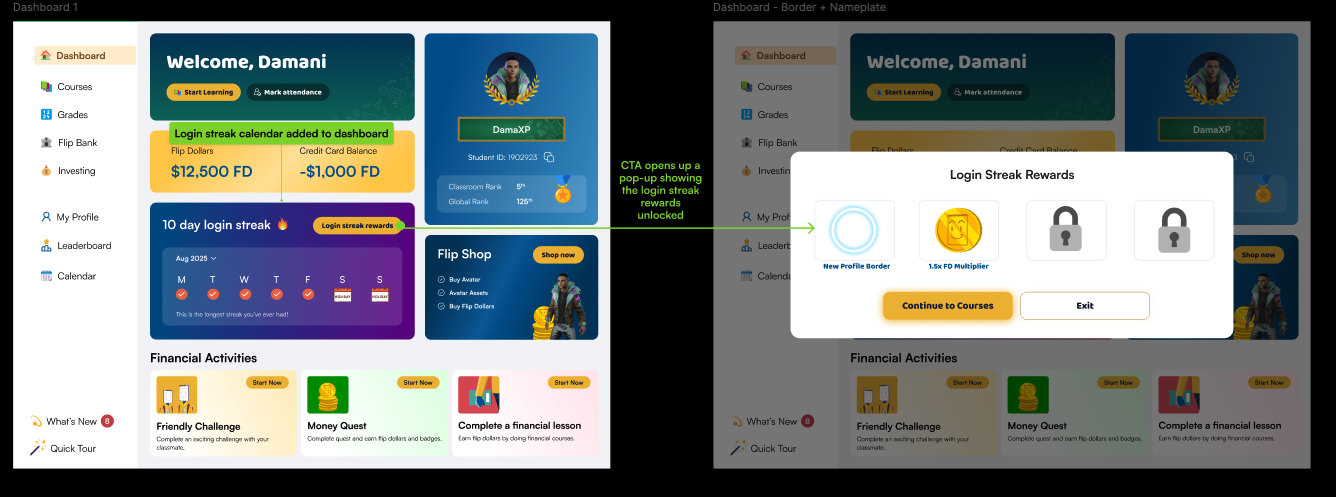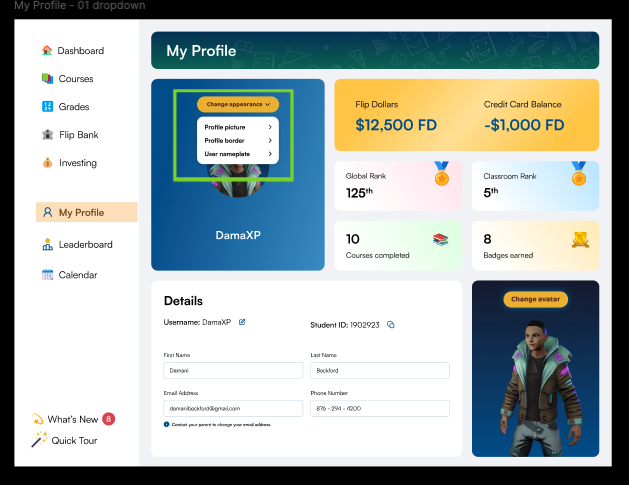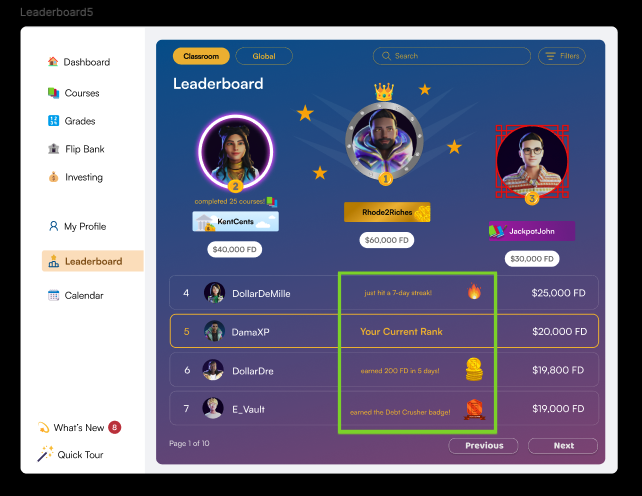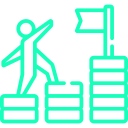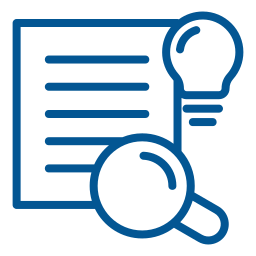Gamifying Financial Literacy
Transforming financial education through interactive gamification for middle school students.

Overview
Duration: Aug 2025- Sept 2025 (5 weeks)
Role: Research, Design, Testing
Organization: Springboard Industry Design Project
The Company
Flip & Floss is an edtech startup dedicated to making financial literacy accessible and engaging for young learners through interactive experiences.
The Platform
Flip Academy, their digital learning platform, offers courses on saving, spending, investing, and debt management.
The Challenge
Low Engagement
Traditional financial education fails to capture students' interest and promote long-term engagement.
Boring Content
Kids think personal finance is boring and need more interactive, game-like experiences.
The Solution
Gamification Gap
Current educational methods lack the gamification needed to make learning fun and memorable.
Unlocking Engagement
Current educational methods lack the gamification needed to make learning fun and memorable.
Design and implement gamification features in a way that is intuitive, educational, and enjoyable for students to build essential financial skills through play and exploration.
Note: The HMWs, Wireframes, and Hi-Fi prototypes were all refined based on the secondary research insights and the design system shared by the Flip & Floss team.
Rewards Drive Engagement
Short games with instant gratification and reward systems like earning currency or cosmetics are particularly motivating.
MyDoh by RBC
Strengths: High trust, strong parental controls, PayDay system
Weaknesses: Banking-like interface, limited learning activities, no rewards for completion
Social Features Matter
Kids value competition and peer interaction. Sharing achievements fosters engagement, especially with incentives.
Learning from the Competitors
Greenlight Financial
Strengths: Gamified Level Up platform, interest on savings
Weaknesses: Separated experience, subscription fees for key features
Simple Interfaces Win
Kids avoid apps with overly complicated interfaces. Clear and simple designs enhance usability and enjoyment.
Till Financial
Strengths: Group savings goals, deposit links, free plan
Weaknesses: No gamification, unwelcoming to younger users
User Persona
Meet Dev: The Goal-Oriented Gamer
Age: 12
Class: 7th Grade
Location: Brampton, Ontario
Goals
Learn money management and goal-setting through engaging play.
Gain independence, track growth, and earn rewards.
Frustrations
Serious, lecture-based learning or dull interfaces.
Lack of immediate feedback, rewards, or personalization.
Needs
A gamified, interactive learning experience with clear visual progress.
Opportunities for peer competition or collaboration.
Motivations
Unlocking new levels, badges, or rewards.
Competing on leaderboards or through friendly challenges.
Being recognized for consistent effort or creativity.
How Might We’s
Based on our research and understanding of Dev's profile, we've identified key questions to guide our design process:
Engaging Challenges
How might we design rewarding, challenge-based experiences that make learning feel like play and keep students coming back for more?
Social Motivation
How might we build friendly competition and social interaction into the platform in a way that boosts motivation and fun?
Interactive Learning Journeys
How might we transform mini video courses into playful, interactive journeys that engage middle schoolers and build financial skills?
Daily login rewards to feel incentivized to consistently engage with the platform
Streak Rewards for recognizing consecutive activity and escalating rewards like multipliers and cosmetics
Friendly Challenges to complete multiplayer-style courses and unlock rewards together
Key User Flows
Peer Recognition to feel encouraged to strive for and exceed goals
Profile Customization - apply stylish borders and nameplates to the avatar and username, so that the profile can be customized and shown off to their peers
Early Sketches
Daily Login Rewards
Ideas: Mystery box reveals, growing progress plant, and spin-to-win wheel
Profile Customization
Ideas: Adding/ changing profile cosmetics such as profile borders and nameplates
Login Streak & Rewards
Ideas: Login streak, streak calendar, and rewards dashboard
Friendly Challenges
Ideas: Inviting multiple players to participate in different challenges
Daily Login Rewards a.k.a Mystery Box Reveal
Login Streak & Rewards
Leaderboard Shoutouts
Profile Customization
Wireframes
Friendly Challenges
High Fidelity Design Flow
Mystery Box Reveal
Leaderboard Shoutouts
Login Streak & Rewards
Profile Customization
Usability Testing
Turning Feedback Into Action
We tested out the high-fidelity prototype of Flip Academy with four middle school students to evaluate usability and identify areas for improvement in navigation, gamification, and engagement.
1 CRITICAL and 1 MAJOR issue were uncovered after the first round of testing.
CRITICAL
Issue: Login rewards and streaks lacked dashboard visibility, impeding user task completion.
Reason:
Login Rewards hidden on dashboard; no clear call-to-action (CTA).
Functionality not clearly linked to Flip Items and Gift Cards tabs.
MAJOR
Issue: Two participants couldn't identify the "I'm at school" CTA for marking attendance.
Reason: The language wasn't straightforward or conventional enough to take the desired action.
What Worked?
*Refer to the green boxes
Engaging Rewards: Participants found the confetti pop-up for login rewards and streak bonuses highly motivating and fun, creating excitement to earn Flip Dollars and redeem rewards.
SOLUTION
Move login rewards and streak visibility to the dashboard, removing them from the Flip Shop, resulting in a dashboard redesign.
SOLUTION
Replace "I'm at School" with "Mark Attendance" on the CTA.
Personalization: Strong appreciation for unlockable nameplates and borders; customization was seen as a key way to stand out and track progression among peers.
Social Motivation: Leaderboard shoutouts motivated participants to improve their rank, and the concept of team-based, friendly challenges with shared rewards was found to be highly engaging.
Next Steps
Conduct further testing to validate design changes.
Design an interactive onboarding tutorial.
Explore advanced gamification (personalized journeys, avatars).
Collaborate with developers for implementation.
Lessons Learned
Collaborating with a startup team taught me about stakeholder alignment, adapting to feedback, and communicating design decisions effectively.
Clarity matters: Even small labels (e.g., “Mark Attendance,” “Start Course”) can confuse if not intuitive to students.
User-first approach: Middle schoolers respond best to straightforward, fun language rather than formal or plain wording.
Gamification Motivates: Rewards, streaks, and shoutouts increase excitement and engagement for students.



